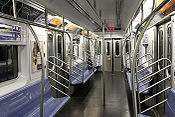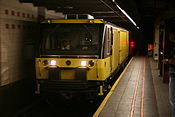- New York City Subway rolling stock
-
The New York City Subway is a large rapid transit system and has a large fleet of rolling stock.
Contents
Overview
 The "Centennial Holiday Shopper's Special", a train of R1, R4, R7A, and R9 cars that ran during the Subway Centennial in late 2004 on the Brighton Line
The "Centennial Holiday Shopper's Special", a train of R1, R4, R7A, and R9 cars that ran during the Subway Centennial in late 2004 on the Brighton Line
 The "2007 Holiday Shopper's Special", December Sundays, a train of R1, R4, R7A, and R9 subway cars running in special service at the 23 Street (6 Avenue) station).
The "2007 Holiday Shopper's Special", December Sundays, a train of R1, R4, R7A, and R9 subway cars running in special service at the 23 Street (6 Avenue) station).
As of June 2011, there are 6,292 cars on the NYCT roster.[1] Train assignments can be found here:[2][3] A typical revenue train consists of 8 to 11 cars, although shuttles can be as short as two, and can range from 150 to 600 feet (45.72 to 182.88 m) long. As a general rule, trains on A Division lines inherited from the IRT (designated with numbers, plus the 42nd Street Shuttle) are shorter and narrower than those that operate on B Division lines inherited from BMT/IND (designated with letters). The A Division and B Division trains operate only in their own division; operating in the other division is not allowed. This is mainly because the IRT sections have narrower tunnel segments, tighter curves, and tighter platform clearances than the BMT/IND sections. IRT Division trains would have an unacceptably large gap between the platform and train if they were allowed in the BMT/IND Division. Likewise, BMT/IND trains would not fit in the IRT tunnels and stations. The safety train stop (trip cock) mechanism between divisions is also incompatible, being located on opposite sides of the track and train in each division. Service and maintenance trains are composed of IRT sized cars, do not carry passengers, and can operate on either division as the safety train stop is built on both sides of the trucks.
The system maintains two separate fleets of cars, one for the IRT lines, another for the BMT/IND lines. All BMT/IND equipment is about 10 feet (3.05 m) wide and either 60 feet 6 inches (18.44 m) or 75 feet 6 inches (23.01 m) long whereas IRT equipment is approximately 8 feet 9 inches (2.67 m) wide and 51 feet (15.54 m) long. There is also a special fleet of BMT/IND cars that is used for operation in the BMT Eastern Division, which is the J, L, M and Z trains. The BMT Eastern Division has sharper curves and shorter platforms, so these trains can only use eight 60-foot (18.29 m) long cars. As of August 2011, R42 married pairs, R143 four-car sets and R160A four-car sets are assigned to the BMT Eastern Division. 75-foot (22.86 m) long cars, like the R44s, R46s, R68s, and R68As are not permitted on BMT Eastern Division trackage.
Cars purchased by the City of New York since the inception of the IND and for the other divisions beginning in 1948 are identified by the letter "R" followed by a number; e.g.: R32. This number is the contract number under which the cars were purchased. Cars with nearby contract numbers (e.g.: R1 through R9, or R21 through R36 WF, or R143 through R160B) may be virtually identical, simply being purchased under different contracts.
When the Brooklyn Rapid Transit Company entered into agreements to operate some of the new subway lines, they made the decision to design a new type of car, 10 feet (3.05 m) wide and 67 feet (20.42 m) long, the subject of several patents, whose larger profile was more similar to that of steam railroad coaches, permitting greater passenger capacity, more comfortable seating and other advantages. The BRT unveiled its design, designated BMT Standard, to the public in 1913 and received such wide acceptance that all future subway lines, whether built for the BRT, the IRT or eventually, the IND, were built to handle the wider cars.
When the R44s and R46s were rebuilt, the rollsigns on the side of the cars were replaced with electronic LCD signs while the front service sign remained as a rollsign. In sharp contrast, the rebuilt R32s and R38s retained rollsigns on the sides, but a digital light display was placed in the front. The MTA has been incorporating newer subway cars into its stock in the past decade. Since 1999, the R142s, R142As, R143s, R160As, and R160Bs have been added into service.[4][5] All cars built since 1992, (including the now out-of-service R110As and R110Bs) are equipped with digital signs on the front, sides, and interior (except for the R110B, which has rollsigns on the front).
Old cars, some from the original companies (IRT and BMT), are preserved at the New York Transit Museum, while others have been sold to private individuals, rail and trolley museums. Between 1984 and 1989 some of the IRT trains were painted red, giving them the name Redbirds. Since then, all of these cars have been replaced by more modern subway trains (R142/R142As) between 2000 and 2005. As of July 2010, many older BMT/IND cars (R32, R38, R40, R40A/M, R42, and R44) have been retired and replaced with the R160s.
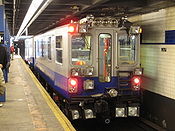 A track geometry car work car at Jay Street – Borough Hall.
A track geometry car work car at Jay Street – Borough Hall.
General Overhaul Program
The General Overhaul Program (GOH) was a mid-life overhaul program for neglected subway cars which involved thorough rebuilding of the fleet. Recently, the new Scheduled Maintenance System (SMS) program has replaced the GOH program by ensuring that trains do not reach a state in which they would need such an overhaul. The car types which were part of the MTA NYCT GOH program are the IRT Redbirds (R26, R28, R29, R33, R33 WF, R36, R36 WF), as well as IND/BMT cars (R30 GE, R32, R38, R40, R40A, R40M, R42, R44 and R46). These cars were rebuilt between 1985 and 1992. Some cars in various classes from R10 to R46 were also given lighter overhauls during this period.
The "R" Prefix
The New York City Board of Transportation settled on a system of documentation that is still in place under MTA New York City Transit. This included a prefix letter or letters that indicated the Department that the specific documentation, followed by a series of numbers of a length defined by the specific department concerned. For example, the Surface Department used the letter "S", while the Rapid Transit Department used the letter "R". A new R number is assigned for any vehicle purchase involving a bidding process. Since the 1970s the system has suffered from "R inflation" going through only 46 R numbers in its first 40 years, but over 114 in its subsequent 30. Possible reasons include an increased number of specialized maintenance vehicles that were previously made in house or a lower floor for requiring a formal bidding process in order to reduce waste and abuse.
Current fleet
A Division
Contract # Year built
and BuilderPhoto Fleet numbers
(Total ordered)Services Yard
assignmentNotes R62 1983-1985
Kawasaki Heavy
Industries
1301-1625
(325 total, 315 in service)
- Originally single cars, now 5-car sets.
- 10 cars retired and scrapped.
R62A 1984-1987
Bombardier
Transportation
1651-2475
(825 total, 824 in service)


- Originally single cars, 1901-2155 still singles, all other cars in 5-car sets.
- One car (1909) retired and scrapped.
R142 1999-2003
Bombardier
Transportation1101–1250,
6301-7180
(1030 total)


- East 180th Street
- 239th Street
- Mosholu
- Cars ending in 1, 5, 6 and 0 have single full-width cabs, and are known as "A" cars.
- Cars ending in 2, 3, 4, 7, 8 and 9 have no cabs, and are known as "B" cars.
- All cars are sequentially numbered in A-B-B-B-A configuration as 5-car sets.
R142A 1999-2004
Kawasaki Heavy
Industries
7211-7810
(600 total)

- Mosholu
- Westchester
- Cars ending in 1, 5, 6 and 0 have single full-width cabs, and are known as "A" cars.
- Cars ending in 2, 3, 4, 7, 8 and 9 have no cabs, and are known as "B" cars.
- All cars are sequentially numbered in A-B-B-B-A configuration as 5-car sets.
- 360 cars (36 trainsets) to be converted to R188 with CBTC compatibility by 2015 for the
 train.
train.
B Division
Contract
#Year built
and BuilderLength Photo Fleet numbers
(Total ordered)Services Yard assignment Notes R32/
R32A1964-1965
Budd Company60 ft. - R32A: 3350-3649
- R32: 3650-3949
(600 total, 222 left in revenue service)

- Married pairs; even numbered cars have motor generator and battery, odd numbered cars have air compressor.
- Mismatched pairs common due to accidents and scrapping.
- Many cars have been retired and replaced by R160A/R160B car order.[6][7]
- Retirement of remaining cars postponed to facilitate retirement of the R44s.
R42 1969-1970
St. Louis Car
Company60 ft. 
4550-4949
(400 total, 48 left in revenue service)

R44 1971-1972
St. Louis Car
Company75 ft. - 388-435
- 436-466 (even
numbers only)
(352 total, 63 in SIR service)
- Clifton
- Even numbered cars have single full-width cabs, and are known as "A" cars
- Odd numbered cars have blind ends, and are known as "B" cars.
- All R44 New York City Subway cars were in A-B-B-A configuration as 4-car sets.
- Staten Island cars are all singles.
- New York City Subway car numbers were originally 100-387 and renumbered 5202–5479.
- All NYCS cars retired in 2010 due to structural integrity issues.
R46 1975-1978
Pullman Company75 ft. 
- 5482-6207
(4 car set) - 6208-6258
(even numbers
only)
(754 total, 752 in service)




- Even numbered cars have single full-width cabs, and are known as "A" cars
- Odd numbered cars have blind ends, and are known as "B" cars.
- Most cars are in A-B-B-A configuration as 4-car sets.
- Higher numbered cars are in A-A configuration (6208-6258), with one pair being an A-B (6206-6207).
- Car numbers were originally 500-1227 and 1228-1278 even numbers only.
- Two cars scrapped prior to General Overhaul: 941, 1054 (original numbering).
R68 1986-1988
Westinghouse Electric
Corporation/AMRail75 ft. 
2500-2924
(425 total)



- Originally single cars, 2500-2915 are now in 4-car sets.
- 2916-2924 are singles used for the Franklin Avenue Shuttle.
R68A 1988-1989
Kawasaki Heavy
Industries75 ft. 5001-5200
(200 total)
- Originally single cars, now 4-car sets.
R143 2001-2003
Kawasaki Heavy
Industries60 ft. 
8101-8312
(212 total, 208 in service)
- All cars are sequentially numbered in A-B-B-A configuration as 4-car sets.
- "A" cars have single full-width cabs, "B" cars have no cabs.
- Four cars (8277, 8278, 8279, 8280) taken out of service in 2006 due to bumper block overshoot incident
R160A 2005-2010
Alstom Transportation60 ft. 
- 8313-8652,
9943-9974
(4-car sets)




- All car sets are sequentially numbered. "A" cars have single full-width cabs, "B" cars have no cabs.
- 8313-8652, 9943-9974 are in A-B-B-A configuration as 4-car sets.
- 8653-8712, 9233-9802; ending in 3, 7, 8 and 2 are "A" cars.
- 8653-8712, 9233-9802; ending in 4, 5, 6, 9, 0 and 1 are "B" cars.
- 8653-8712, 9233-9802 are in A-B-B-B-A configuration as 5-car sets.
- 8653-8712,
9233-9802
(5-car sets) [8]
(1002 cars total)



R160B 2005-2010
Kawasaki Heavy
Industries60 ft. 
8713-9232,
9803-9942[8]
(660 cars total)



- Cars ending in 3, 7, 8 and 2 have single full-width cabs, and are known as "A" cars.
- Cars ending in 4, 5, 6, 9, 0 and 1 have no cabs, and are known as "B" cars.
- All cars are sequentially numbered in A-B-B-B-A configuration as 5-car sets.
Future fleet
Contract # Division Builder
Year To Be BuiltTotal Notes R179 B N/A 2012-
350 (52 5 car operating units + 10 4 cars operating units + 10 optional 5 car operating units) + 80 additional option cars pending funding To be ordered, consists of 340 cars to replace R32s and R42s on the IND/BMT. Additional 80 cars to displace selected R46s to SIR and retire the R44s. R188 A Kawasaki Heavy Industries
2011-2015506 CBTC-compatible.
To be ordered; cars in 5-car and 6-car sets for the 7 train. Order consists of a combination of 146 new cars, R142A conversions by the manufacturer, and car conversion kits supplied by the manufacturer for the NYCTA to perform onsite, totalling 360 car conversions.[9][10]R211 B N/A 2015-
An amount roughly equivalent in capacity to 752 75 foot cars. To be ordered, replacing R46 cars in 2015. Design draft slated for 2012 Retired fleet
IRT Pre-Unification listing
Designation Year built Division Builder Fleet total Car numbers Year
retiredDenotes Composite 1903–1904 IRT Jewett,
St. Louis Car,
Stephenson,
Wason500 2000–2159,
3000-33391916
19502000–2159: Non-powered Trailers only
Retired from Subway service in 1916;
re-equipped with lightweight trucks and components; and continued in elevated service until 1950.Hi-V "Gibbs" 1904–1905 IRT American Car & Foundry 300 3350-3649 1959 Hi-V "Deck Roof" 1907–1908 IRT American Car & Foundry 50 3650-3699 1959 Hi-V "Hedley" 1910–1911 IRT American Car & Foundry,
Standard Steel,
Pressed Steel325 ACF: 3700-3809,
SS: 3810-3849,
PS: 3850-40241959 Hi-V "Hedley" 1915 IRT Pullman 292 4223-4514 1959 Non-powered Trailers only;
4223-4250 in their last years were motorized as blind motors with no controls.Lo-V "Flivver" 1915 IRT Pullman 178 4037-4160,
4161-42141962 Were built with the original trucks and electrical components removed from the Composites. Lo-V "Steinway" 1915–1916 IRT Pullman 110 4025-4036,
4215-4222,
4555-4576,
4700-4770Equipped with special gearing for the steep grades of the Steinway Tunnels. Lo-V 1916–1917 IRT Pullman 695 4515-4554,
4577-4699,
4771-4810,
4811-4965,
4966-53024515-4554 and 4811-4965: Non-powered Trailers only Lo-V 1922 IRT Pullman 100 5303-5377,
5378-5402Non-powered Trailers only;
5303-5377 equipped with air compressors for brakesLo-V 1924–1925 IRT American Car & Foundry 225 5403-5627 1964 Lo-V "Steinway" 1925 IRT American Car & Foundry 25 5628-5652 Equipped with special gearing for the steep grades of the Steinway Tunnels. Lo-V "World's Fair" 1938 IRT St. Louis Car 50 5653-5702 BMT Pre-Unification listing
Designation Year built Division Builder Fleet
totalCar numbers Year
retiredDenotes AB Standard 1914–1919 BMT American Car & Foundry 600 2000-2599 1969 AB Standard 1920–1922 BMT Pressed Steel 300 2600–2899 1969 AB Standard 1924 BMT Pressed Steel 50 4000-4049 1961 Non-powered Trailers only BMT-SIRT (ME-1) 1925 SIR, BMT Standard Steel 25 2900–2924 1961 25 motor cars purchased from the Staten Island Railway in 1954. D-type Triplex 1925–1928 BMT Pressed Steel 121 6000-6120 1965 Green Hornet 1934 BMT Pullman 1 7003 1942 Experimental unit; scrapped in 1942 for the war. Zephyr 1934 BMT Budd 1 7029 1954 Experimental unit Multi 1936 BMT St. Louis Car 10 7004-7013 1961 Multi 1936 BMT Pullman 15 7014-7028 1961 Bluebird 1938, 1940 BMT Clark 6 8000-8005 1957 R-type listing
Contract # Year built Division Builder Fleet total Car numbers Year retired Denotes R1 1930–1931 IND American Car & Foundry 300 100-399 1977 R4 1932–1933 IND American Car & Foundry 500 400-899 1977 R-6-3 1935–1936 IND American Car & Foundry 250 900-1149 1977 R-6-2 1936 IND Pullman 150 1150–1299 1977 R-6-1 1936 IND Pressed Steel 100 1300–1399 1977 R7 1937 IND American Car & Foundry, 150 ACF: 1400-1474,
Pullman: 1475–1549
1977 R7A 1938 IND American Car & Foundry, 100 Pullman: 1550–1599,
ACF: 1600-16491977 R9 1940 IND, BMT
American Car & Foundry, 153 ACF: 1650-1701,
PS: 1702-18021977 R10 1948–1949 IND, BMT
American Car & Foundry 400 1803–1852,
3000-33491989 Car number series selected to bracket the Pre-Unification BMT number series 1853-2999.
Cars 1803-1852 were renumbered as 2950-2999 in 1970.R11 1949 BMT, Budd 10 8010-8019 1977 Number series selected to continue from the Pre-unification BMT number series.
Test trains, rebuilt into R34 cars in 1965.R12 1948 IRT American Car & Foundry 100 5703-5802 1981 Car Number series selected to continue from the Pre-unification IRT number series.
Rollsigns displayed Post-unification IRT number series, first introduced in 1948.R14 1949 IRT American Car & Foundry 150 5803-5952 1984 R15 1950 IRT American Car & Foundry 100 5953-5999,
6200-62521984 R16 1955 BMT, American Car & Foundry 200 6300-6499 1987 R17 1955–1956 IRT St. Louis Car 400 6500-6899 1988 R21 1956 IRT St. Louis Car 250 7050-7299 1987 R22 1957 IRT St. Louis Car 450 7300-7749 1987 R26 1959–1960 IRT American Car & Foundry 110 7750-7859 2002 Married Pairs
Even numbered cars have Motor Generator and battery, Odd numbered cars have Air Compressor.R27 1960–1961 IND, BMT
St. Louis Car 230 8020-8249 1990 Married Pairs
Even numbered cars have Motor Generator and battery, Odd numbered cars have Air Compressor.R28 1960–1961 IRT American Car & Foundry 100 7860-7959 2002 Married Pairs
Even numbered cars have Motor Generator and battery, Odd numbered cars have Air Compressor.R29 1962 IRT St. Louis Car 236 8570-8805 2002 Married Pairs
Even numbered cars have Motor Generator and battery, Odd numbered cars have Air Compressor.R30 / R30A 1961–1962 IND, BMT
St. Louis Car 320 R30: 8250-8351
R30A: 8352-8411
R30: 8412-85691993 Married Pairs
Even numbered cars have Motor Generator and battery, Odd numbered cars have Air Compressor.R33 1962–1963 IRT St. Louis Car 500 8806-9305 2003 Married Pairs
Even numbered cars have Motor Generator and battery, Odd numbered cars have Air Compressor.R33 WF 1963 IRT St. Louis Car 40 9306-9345 2003 single cars, built for IRT Flushing Line
some now in work serviceR34 see R11 R36 1963–1964 IRT St. Louis Car 34 9524-9557 2003 Married Pairs
Even numbered cars have Motor Generator and battery, Odd numbered cars have Air Compressor.R36 WF 1963–1964 IRT St. Louis Car 390 9346-9523,
9558-97692003 Married Pairs
Even numbered cars have Motor Generator and battery, Odd numbered cars have Air Compressor.R38 1966–1967 IND, BMT
St. Louis Car 200 3950-4149 2009 Married Pairs
Even numbered cars have Motor Generator and battery, Odd numbered cars have Air Compressor.R39 Never built IRT, BMT
R40 1968-
1969IND, BMT
St. Louis Car Company 200 4150-4349 2009 Slanted ends, married pairs
Even numbered cars have motor generator and battery, Odd numbered cars have air compressor
Car numbers were originally 4150-4249, 4350-4449R40A/
R40M1968–1969 IND, BMT
St. Louis Car
Company200 4350-4549 2009 Married pairs
Even numbered cars have motor generator and battery, odd numbered cars have air compressor
Car numbers were originally 4250-4349 (modified),[11] 4450-4549 (slant)[12]R55 Never built IND, BMT
The R55 was a proposed car[13] for the B Division (IND/BMT).
It was considered in the early 1980s, but never left the drawing board.
This order later evolved into the future R68.R110A 1992 IRT Kawasaki 10 8001-8010 1999 (Built as Contract R130)
New Technology demonstrator
cars ending in 1, 5, 6 and 0 have single full-width cabs, and are known as "A" cars.
cars ending in 2, 3, 4, 7, 8 and 9 have no cabs, and are known as "B" cars.
All cars are sequentially numbered in A-B-B-B-A configuration as 5-car sets.
All cars are stored at Concourse Yard as of June 19, 2009 [1]R110B 1992 IND, BMT
Bombardier 9 3001-3009 2000 (Built as Contract R131)
New Technology demonstrator, 67-foot (20 m) car
cars ending in 1, 3, 4, 6, 7 and 9 have single full-width cabs, and are known as "A" cars.
cars ending in 2, 5 and 8 have no cabs, and are known as "B" cars.
All cars are sequentially numbered in A-B-A configuration as 3-car sets.
Set 3001-3004 and 3007-3009 are stored at 207th Street Yard. The other three are used for training.Notes
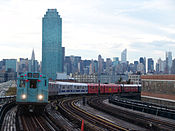 The "Train of Many Colors" operates in late 2004 as a Subway Centennial special on the #7 train
The "Train of Many Colors" operates in late 2004 as a Subway Centennial special on the #7 train
 The "Train of Many Colors" makes another appearance on the #7 train in 2008, commemorating the last game at Shea Stadium
The "Train of Many Colors" makes another appearance on the #7 train in 2008, commemorating the last game at Shea Stadium
- Most IND/BMT (Division B) cars are 60 feet (18 m) long unless noted; all IRT (Division A) cars are 51 feet (16 m).
- R44, R46, R68, R68A are 75 feet (23 m) long
- All cars R38 and after are stainless steel.
- Air conditioning is standard on all cars R42 and later. R38s 4140-49 and R40s 4350-4549 were also delivered with A/C, and all cars not equipped with A/C from classes R26-R40 (With the exception of the R27, R30, and R33WF) were later retrofitted with A/C. All active cars are equipped with air conditioning.
- "Number of cars" is the total number built per model and does not account for cars wrecked, scrapped, etc.
- Redbirds are R26, 28, 29, 30, 33 and 36. Many cars are still in use as work trains (Most remaining cars are R33s). Sometimes the term "Redbird" would also be used on the R27 and R30 cars as they were repainted gunn red during the late 1980s and early 1990s before retirement. These were known as the BMT Redbirds.
- R39 and R55 were never built.
- During World War II, a group of old New York elevated line cars dating from the late 19th century was sent west to the San Francisco Bay Area by the United States Maritime Commission for use by the Shipyard Railway, a temporary wartime electric line transporting workers to the Kaiser Shipyards. After the war, most were sold to be used as units in a local motel, but their whereabouts afterwards is unknown. Two of them however were acquired and have been restored by the Western Railway Museum in Rio Vista, California. (See photos at [14])
- There are many other different contracted trains such as R95 and R127 which are not used for revenue service.
External links
- nycsubway.org - New York City Subway Cars
- - Pre-Unification Cars (BMT)
- - Pre-Unification Cars (IRT)
- - R-Type Cars 1932 to 1987
- - R-Type Cars 1999 to Present (NTT)
- - 'R' Type Roster (includes non-train contracts)
- Forgotten NY Subway Link
- MTA Subway Yard Roster
- B Division Train Set Assignments
- A Division Train Set Assignments
References
- ^ "New York City Subway Car Fleet June 2010 through June 2011". TheJoeCorner. http://www.thejoekorner.com/cars/cars-current.htm. Retrieved November 12, 2011.
- ^ B Division Train Assignments 10-03-2011
- ^ A Division Train Assignments 06-26-2011
- ^ "R160A in service on N". http://www.nycsubway.org/perl/show?59931.
- ^ "R160B in service on N". http://www.nycsubway.org/perl/show?59998.
- ^ "R32 3422 awaiting final disposal at 207th Street Yard" Retrieved on 2008-04-16
- ^ "R32 3573 awaiting final disposal at 207th Street Yard" Retrieved on 2008-04-16
- ^ a b "R160A & R160B Car Numbers" Retrieved on 2008-05-04
- ^ Page 32 (Footnotes)
- ^ http://www.subchat.com/read.asp?Id=927848
- ^ R40A Modified with Original Numbers (Shown is 4250)
- ^ R40A Slant with Original Numbers (Shown is 4460)
- ^ "Roster Summary By Type". www.nycsubway.org. http://www.nycsubway.org/cars/bytype.html. Retrieved 2009-08-25.
- ^ "Richmond Shipyard Railway 1943-1945" Retrieved on 2008-04-16
- Sansone, Gene. Evolution of New York City subways: An illustrated history of New York City's transit cars, 1867-1997. New York Transit Museum Press, New York, 1997. ISBN 978-0963749284.
- Kramer, Frederick A. Building the Independent Subway. Quadrant Press, Inc.; New York, 1990. ISBN 0-915276-50-X
- Cudahy, Brian J. Under the Sidewalks of New York: The Story of the Greatest Subway System in the World, 2nd Revised Edition. Fordham University Press, New York, 1995. ISBN 0-8232-1618-7
- Dougherty, Peter J. Tracks of the New York City Subway, version 4.2. 2007
New York City Subway revenue rolling stock Current B Division/ SIR :


Future B Division / SIR :R179 • R211A Division :R188Retired
(R-type)IND/BMT (B Division) :IRT (A Division) :Retired
(private
operators)IRT :Composite • Gibbs Hi-V • Deck Roof Hi-V • Hedley Hi-V • Steinway Lo-V • "Flivver" Lo-V • Standard Lo-V • World's Fair Lo-VBMT / SIRElevated :Subway :Never built New York City Subway Services 


Unused
or defunct8 · 9 · AA · BB · CC · EE (8 Avenue) · EE (Broadway) · GG · H · HH (Court Street) · HH (Rockaway Park) · JJ · K (Jamaica) · K (8 Avenue) · KK · LL · MJ · NX · P · QB · QJ · QT · RJ · RR · T · TT · U · V · W · X · Y · JFK Express
ShuttlesBMTCapital projects Divisions A Division (IRT) · B Division (BMT · IND)Stations BoroughsThe Bronx · Brooklyn · Manhattan · QueensTypesOther lists Miscellaneous Staten Island Railway · Automation · Chaining · History · Fares · MetroCard · Nomenclature · Rolling stock · Proposed expansion (1929–1940)Metropolitan Transportation Authority of the State of New York Bus 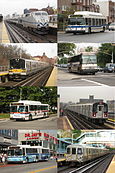
Rapid transit Commuter rail Crossings MTA Bridges and TunnelsLaw enforcement Fleet Subway • Bus • Long Island Rail Road • Metro-North RailroadOther Categories:- New York City Subway passenger equipment
Wikimedia Foundation. 2010.

